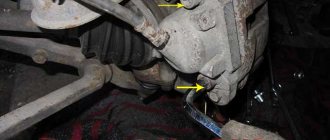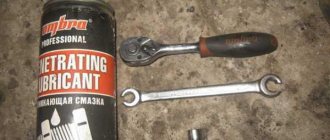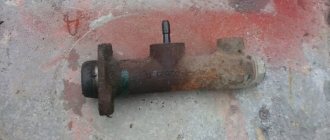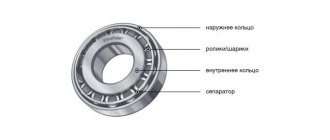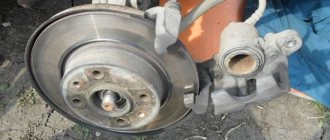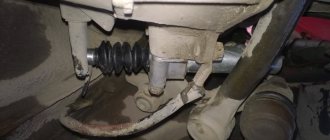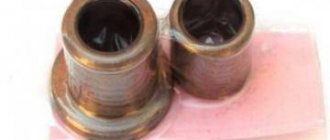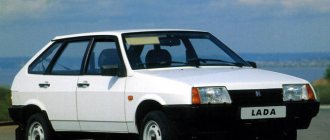Repair of the front caliper VAZ 2110
The caliper in a car is one of the most important parts.
It is a unit necessary for attaching the brake pads of a vehicle. Only a small proportion of drivers pay due attention to the braking system, although this part of the car should be a priority. Many owners of domestic VAZ cars have managed to appreciate the importance of the caliper, or rather, the need for its full serviceability. For example, some drivers almost crashed into the vehicle in front because the braking system failed at the most inopportune moment.
The driver should definitely periodically check the serviceability of the brake caliper on the VAZ 2110 and other domestic car models. If this part is damaged, it can be restored. In cases where the possibility of restoring the caliper is excluded, the component part is completely replaced.
Caliper device
In the family of front-wheel drive VAZ cars, disc brakes and, accordingly, calipers are installed only on the front axle. There are drum brakes at the rear.
The VAZ-2108 caliper is clearly visible if the steering wheel is turned all the way and the wheels are at an angle to the car’s axis. It is also clearly visible with the front wheels removed. The massive part that fits the brake disc is the caliper. It consists of the following elements:
- Fixed metal bracket. It plays the role of a frame on which the entire structure is assembled. Attached to the steering knuckle.
- Movable bracket. It moves relatively movably with the help of connecting fingers that serve as guides.
- Working cylinder. It is an oblong part that houses a hydraulic piston. It is fixed to the movable bracket of the brake caliper - VAZ 2108. The working cylinder has a fitting for pumping and bleeding air. As well as connection to the hydraulic brake system.
- Brake linings. Using cotter pins, they are fixed in a movable bracket.
In addition to the listed parts, there are several bolts that are used to secure the caliper.
Replacing caliper guide pins and their boots on VAZ 2114-2115
The first step is to jack up the front of the car. Then remove the wheel and use a flat-blade screwdriver to bend the locking washers of the caliper bolts.
Then unscrew the two fastening bolts at the top and bottom, as shown in the photo.
Next, compress the brake cylinder using a screwdriver by inserting it between the bracket and one of the pads.
Next, you can lift the cylinder with the bracket up, as shown below, and move it to the side so that it is out of the way.
And now you can easily remove the caliper pins, both from above and from below, with minimal effort.
Then we clean the fingers from the old grease with a special product or buy a new one. Also, it is necessary to install a new boot if the old one is damaged.
Apply special caliper grease to the pin and under the boot, as shown in the photo. Then we put the finger in its place all the way so that the boot is securely fixed.
Now you can assemble the entire structure in reverse order, and do not forget to press the brake pedal several times before leaving the repair site so that the pads take their position in the guide.
Replacing caliper guide pins
If you begin to notice rattling of the calipers on your own car, then you should first pay attention to two things:
- On brake pad springs that may have weakened
- The caliper guide pins may have worn out due to lack of lubrication.
This article will examine the second option, when specific wear on the guide pins leads to similar dilemmas. First, you should pay attention to the condition of the anthers. If they are torn or even cracked, then they need to be replaced with new ones, and the fingers themselves must be re-lubricated. But more on this below.
Necessary tool for inspecting calipers on VAZ 2110, 2111 and 2112
- Flat blade screwdriver
- 13 and 17 mm wrench
- Copper grease
- Lubricant for caliper guide pins
- Brake Cleaner
Repair
After preliminary cleaning of the caliper parts, they need to be degreased and painted. Before applying paint, all holes are sealed with masking tape. You need to paint in several layers. To completely destroy traces of corrosion remaining after brushing, parts can be etched with phosphoric acid before painting.
The removed piston of the VAZ-2108 caliper should be carefully inspected for scoring. Then you need to polish the interface between this part and the cylinder with water using 2000-3000 grit sandpaper.
After drying, the piston, lubricated with brake fluid, is installed in place. At the same time, a new bleeder fitting is installed.
The repair kit contains new rubber seals, including rubber bands that protect the guides of the VAZ 2108 caliper. During assembly, all boots, O-rings, and cuffs are installed with new ones.
Do-it-yourself dismantling of the caliper on a VAZ-2110
The very simple design of the product and the triviality of the process of dismantling it allow even a novice motorist to carry out repairs and maintenance. If you carefully follow the recommendations below, you are unlikely to encounter difficulties at any stage of the process. You will save a lot of money spent on a trip to a service station, and a considerable amount of time, because the service time is comparable to the time required to travel to the workshop.
Dismantling VAZ caliper
The sequence for dismantling the product is as follows:
- The first step is to jack up the car and remove the wheel. To be on the safe side, it can then be placed under the bottom of the car in case the jack fails;
- On a VAZ 2112, the caliper is attached to the bracket using two M17 bolts, which you should unscrew. Penetrating lubricant may be needed to strip the bolts;
- If you need to replace the VAZ caliper or carry out a comprehensive repair, unscrew the product from the brake hose. You seal the hose tip and you can begin further disassembling the product.
Further dismantling
Holding the caliper in a vice, unscrew the two bolts under the Torx head and remove the guide pins. After this, the assembly unit splits into three parts: a movable bracket, a brake cylinder and a fixed bracket.
All these three parts must first be cleaned with a brush clamped into a drill. Then you need to proceed to the main part of the repair - restoring the mobility of the piston. To remove it from the brake cylinder, do the following:
- Using a flathead screwdriver, remove the retaining ring that secures the boot. Thanks to it, dirt does not get inside the mechanism.
- Remove the VAZ-2108 caliper boot.
- Remove the piston. Ideally, it is removed using compressed air, which is supplied to the brake fluid supply hole. If the compressor is not available, then the piston is removed using pliers. It is necessary to apply efforts alternately to opposite sides so that there is no distortion, which will complicate dismantling.
- Remove the bleeder fitting.
- Remove the sealing ring between the piston and the cylinder walls.
Lubricating calipers: how, with what and why?
Any “extra” sound coming from the front suspension will certainly alert an experienced motorist. A worn-out bearing, a loose ball or a spinning wheel can lead to loss of controllability and even cause an accident. However, of the many knocks that chassis parts can make, the one that stands out the most is the sound made by the brake calipers - or rather, their brackets and guides. Today we will fight him.
This unpleasant and loud defect is known firsthand to many drivers, and it causes completely different reactions. Most often, the owner prefers “not to interfere with the car’s operation” - after all, this is the easiest way, and the “sound accompaniment” does not particularly affect the operation of the braking system itself. However, there are many meticulous motorists who fight sound in various ways - for example, by lubricating the guides and even modifying them.
The knocking noise occurs due to excessive clearance in the guide-bracket pair.
What to lubricate
It would seem that what could be simpler than lubricating the caliper guides? Many owners do this - during the next “overhaul” of the brake system, they take and lubricate their fingers with whatever comes to hand. As a rule, the garage assortment includes lithol and its derivatives, as well as graphite. More advanced people are puzzled by finding a specialized composition intended specifically for use in brake system components.
And now - surprise: in most cases, both of them do the wrong thing! Yes, the caliper guide pins do need to be lubricated, but not with what is usually considered a suitable lubricant, even if it is positioned as such in a car shop.
Car manufacturers produce guide lubricants under their own brands.
Here is a list of original OEM lubricants from some automakers, indicating catalog numbers:
- BMW 81 22 9 407 103, 83 23 0 305 690;
- FORD/Motorcraft D7AZ-19A331-A, XG-3-A;
- Volkswagen/Audi G 052 150 A2;
- LAND ROVER RTC7603, SYL500010;
- HONDA 08C30-B0224M, 08798-9027;
- MAZDA 0000-77-XG3A;
- NISSAN 999MP-AB002;
- SUZUKI 99000-25100;
- TOYOTA 08887-80609;
- CHRYSLER/Mopar J8993704;
- Volvo 1161325-4.
There are also lubricants produced by companies producing auto components and chemicals under their own brands:
- ACDelco 89021537 (10-4022);
- Federal Mogul F132005;
- FTE Automotive W0109;
- Stahlgruber 223 1712, 223 1729;
- TRW Automotive PFG110.
Such different lubricants
Unfortunately, in the vast majority of cases, car dealerships (both online and offline) will usually offer “the wrong thing” - that is, anti-creaking lubricant, which simply cannot be used in guides!
The fact is that copper and ceramic anti-squeak pastes are intended for application to the back side of the pads and mating elements of brake calipers, but they are not suitable for “guides” for several reasons. Firstly, after lubrication with grease, lithol, “graphite” and other lubricants based on mineral oils, the rubber boots on the fingers almost always swell, stop sticking to the fingers and, in fact, simply stop performing their function.
Secondly, only special greases based on synthetic oils and a thickener are suitable for lubricating the guides. Thanks to this, the lubricant becomes refractory and does not “drain” from the guides after heating, and also does not coke over time from exposure to water and high temperatures. High-quality specialized lubricants can easily hold up to +300C, but at the same time they are non-aggressive to seals. Moreover, such lubricants not only do not melt, but also do not dissolve in water, alkalis, dilute acids, brake fluid, as well as methanol and ethanol.
Using the wrong lubricant in practice can lead to the opposite effect - that is, the lubricated guide pins become sour in the caliper, which is why the floating bracket loses its mobility, and the pads begin to jam and overheat.
On thematic forums, hundreds of pages are devoted to choosing the “right” lubricant for guides, but the theoretical calculations and practical reviews given often contradict each other, which leads to even greater confusion.
Brake fluid leak
You can find out where the brake fluid goes only by visually inspecting the brake valves, front calipers, and rear cylinders. The presence of drips will indicate a leak. If the fluid leaves, but no traces of it are visually visible, most likely the master brake cylinder is to blame, which allows fluid to pass into the vacuum brake booster chamber. This problem also does not arise instantly and before reaching a critical point, when the pedal goes to the floor and the brakes do not work, it will lose elasticity for some time until air enters the system.
There can be quite a few reasons, but the main ones can be outlined as follows:
- wear of the cuffs of the main or working brake cylinders;
- wear of the mirror surface of the working or master cylinder;
- violation of the tightness of the brake hoses on the front struts of the VAZ 2109;
- fluid leakage due to wear of brake pads due to a critical increase in operating
- stroke of the working cylinders.
In short, the easiest way to deal with a brake fluid leak, especially an obvious one, is to simply eliminate the cause of the leak and bleed the brakes.
Front brake pad guide bracket VAZ 2112 R14 (1 piece)
- We guarantee fast processing of your order during business hours (we work from 11-00 to 20-00, Saturday and Sunday are days off).
- We guarantee reliable packaging of your order (when sending it by Russian Post or transport company).
- We guarantee the fastest possible dispatch of your paid order (within 2-4 business days after receipt of payment).
- We guarantee a refund or exchange for another product (with recalculation) within 14 days from the date of receipt of the order (the product must be in good condition, without traces of installation, delivery costs are not reimbursed).
- We guarantee a free exchange of goods (transportation costs at our expense) if the purchased goods turn out to be defective.
Replacing a faulty brake cylinder
The replacement scheme in the VAZ family is almost the same for cylinders of both circuits with minor differences.
Initially, you need to prepare the necessary keys and plugs suitable for the size of the pipes. After removing the wheel and unscrewing the pipes, we put plugs on them to prevent fluid leakage. Having unscrewed the corresponding nuts, we dismantle the old cylinder and put a new one in its place, reassembling it in the reverse order. If, after replacement, wheel assembly is hindered by pads that are too far apart, you can file the ends of the pads, just don’t overdo it, as this may affect the operation of the handbrake.
After any manipulations with the brake system, it must be bled according to the diagram.
I have an old-style UAZ master brake cylinder installed, that is, it has not one fluid reservoir, but two separate ones. There is nothing complicated when replacing it, it is changed in the same way as on the UAZ 469, UAZ 3151, “loaf”. The tubes of the front and rear brake systems are unscrewed. The cylinder is unscrewed, and a new one is installed in its place, then the tubes are connected.
Examples of prices for current items
When buying a caliper for a VAZ 2109-2115, you can operate with the available amount, since there are quite a lot of good quality analogues to choose from, namely:
- Caliper assembly, R13 TRIALLI – RUB 1,880.
- ATE assembled with a ventilated moving bracket – RUB 2,480.
- LUCAS with an extended hose (without adapter) – RUB 4,050.
- LADA (standard set for R13 wheel) – 4,270 rub.
The choice of calipers is represented by more than 17 analogues, 2 original brands and 3 brands operating under AvtoVAZ license. Consequently, the price may change based on the financial policy of the manufacturer, as well as the final cost of the caliper.
Causes of jamming and creaking
Now directly about how to determine the presence of a problem.
The primary sign indicating a malfunction in the calipers of a car brake system is squeaking.
How to restore rights if lost: choose the quick method
It is the creaking that indicates that the element is seriously worn out. In the near future, the unit must be replaced without fail, which the car literally and figuratively screams about. It is extremely difficult not to hear such a creak. But for some reason, thousands of motorists still stubbornly ignore it. As a result, they pay a rather high price. Sometimes even to the point of road accidents resulting from brake failure while driving. To prevent this, you need to understand the issue and understand the essence of what is happening.
The first step is to look at the possible causes. In fact, there are several potential problems to look for. Some of them arise due to the fault of the motorist, others are caused by the natural process of wear and tear.
In any case, the appearance of a squeak as a symptom is a harbinger that at the most inopportune moment the caliper may simply jam.
If you know the reasons, you can prevent them and troubleshoot them by contacting a car service center or solving the problem yourself.
The reasons are:
- The brake pads were initially installed incorrectly. As a result, they are not strictly parallel to the response drives. Because of this, creaking often appears;
- The brake discs are seriously worn out. The reasons are natural wear and tear and aggressive use of the car;
- There is no lubrication in the unit. Initially there was little of it, or it was used up;
- The lubricant was selected incorrectly. Many people skimp on lubricant intended for calipers, hence the consequences.
The most undesirable and dangerous situation is rightly considered when the piston does not return and the unit begins to jam during operation.
Imagine that you are driving a car, press the brake, and then accelerate again. But at the same time, the calipers do not release the front brakes. Additional resistance arises, the car tries to move, but cannot. The result is uncontrolled braking, extremely intense wear and serious overheating of the entire system.
